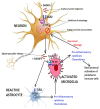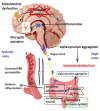The Involvement of Neuroinflammation in the Onset and Progression of Parkinson's Disease
- PMID: 37834030
- PMCID: PMC10573049
- DOI: 10.3390/ijms241914582
The Involvement of Neuroinflammation in the Onset and Progression of Parkinson's Disease
Abstract
Parkinson's disease is a neurodegenerative disease exhibiting the fastest growth in incidence in recent years. As with most neurodegenerative diseases, the pathophysiology is incompletely elucidated, but compelling evidence implicates inflammation, both in the central nervous system and in the periphery, in the initiation and progression of the disease, although it is not yet clear what triggers this inflammatory response and where it begins. Gut dysbiosis seems to be a likely candidate for the initiation of the systemic inflammation. The therapies in current use provide only symptomatic relief, but do not interfere with the disease progression. Nonetheless, animal models have shown promising results with therapies that target various vicious neuroinflammatory cascades. Translating these therapeutic strategies into clinical trials is still in its infancy, and a series of issues, such as the exact timing, identifying biomarkers able to identify Parkinson's disease in early and pre-symptomatic stages, or the proper indications of genetic testing in the population at large, will need to be settled in future guidelines.
Keywords: M1 phenotype; M2 phenotype; Parkinson’s disease; astroglia; gut dysbiosis; microglia; neuroinflammation; signaling pathways; therapy; α-synuclein.
Conflict of interest statement
The authors declare no conflict of interest.
Figures



References
Publication types
MeSH terms
Substances
LinkOut - more resources
Full Text Sources
Medical
Research Materials

